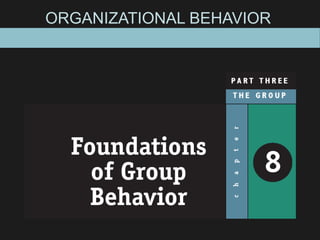
Group processes
- 2. AFTER STUDYING THIS CHAPTER, YOU SHOULD BE ABLE TO: 1. Differentiate between formal and informal groups. 2. Compare two models of group development. 3. Explain how group interaction can be analyzed. 4. Identify the key factors in explaining group behavior. 5. Explain how role requirements change in different situations. L E A R N I N G O B J E C T I V E S
- 3. AFTER STUDYING THIS CHAPTER, YOU SHOULD BE ABLE TO: 6. Describe how norms exert influence on an individual’s behavior. 7. Define social loafing and its effect on group performance. 8. Identify the benefits and disadvantages of cohesive groups. 9. List the strengths and weaknesses of group decision making. 10. Contrast the effectiveness of interacting, brainstorming, nominal and electronic meeting groups. L E A R N I N G O B J E C T I V E S (cont’d)
- 4. Defining and Classifying Groups
- 5. Defining and Classifying Groups (cont’d)
- 6. Types of Groups FORMAL GROUPS COMMAND AND TASK GROUPS (COMMITTEES, COMMISSIONS, BOARDS, TEAMS, TASK FORCES) INFORMAL GROUPS FRIENDSHIP AND INTEREST GROUPS Large (Secondary) Vs Small groups (Primary) Coalition Vs. Membership Group
- 7. Why People Join Groups • Security • Status • Self-esteem • Affiliation • Power • Goal Achievement E X H I B I T 8-1
- 8. Why do Group form 1. Propinquity theory (when people have geographical proximity ie work in same office, come from same are they form groups) 2. Balance Theory (People having similar attitude, values and interest come together and form groups) 3. Exchange theory (People interact with others on the basis of reward – Cost out come, if the out come is positive the group is formed and interaction become more)
- 9. Stages of Group Development
- 10. Stages of Group Development (cont’d)
- 11. Stages of Group Development E X H I B I T 8-2
- 12. An Alternative Model: For Temporary Groups with Deadlines Sequence of actions: 1. Setting group direction 2. First phase of inertia 3. Half-way point transition 4. Major changes 5. Second phase of inertia 6. Accelerated activity
- 13. The Punctuated-Equilibrium Model E X H I B I T 8-3
- 14. Group Behavior Model E X H I B I T 8-4
- 15. External Conditions Imposed on the Group Imposed Conditions: • Organization’s overall strategy • Authority structures • Formal regulations • Resource constraints • Selection process • Performance and evaluation system • Organization’s culture • Physical work setting
- 16. Group Member Resources Knowledge, Skills, and Abilities – Interpersonal skills • Conflict management and resolution • Collaborative problem solving • Communication – Personality Characteristics • Sociability • Initiative • Openness • Flexibility
- 17. Group Structure - Roles Formal Leadership – Leadership that is imposed on the group by the organization. – Leaders who derive their power from the positions they occupy in the organizational structure. – Formal leaders may or may not also be the informal leaders of the groups in which they function.
- 18. Group Structure - Roles (cont’d)
- 19. Group Structure - Roles (cont’d)
- 20. Group Structure - Norms Classes of Norms: • Performance norms • Appearance norms • Social arrangement norms • Allocation of resources norms
- 21. Group Structure - Norms (cont’d)
- 22. Group Structure - Status Group Norms Status Equity Culture Group Member Status
- 23. Group Structure - Size Group Size Performance Other conclusions: • Odd number groups do better than even. • Groups of 7 or 9 perform better overall than larger or smaller groups.
- 24. Group Structure - Composition
- 25. Group Structure - Cohesiveness Increasing group cohesiveness: 1. Make the group smaller. 2. Encourage agreement with group goals. 3. Increase time members spend together. 4. Increase group status and admission difficultly. 5. Stimulate competition with other groups. 6. Give rewards to the group, not individuals. 7. Physically isolate the group.
- 26. Relationship Between Group Cohesiveness, Performance Norms, and Productivity E X H I B I T 8-7
- 27. Group Processes
- 28. Effects of Group Processes E X H I B I T 8-8 + – =
- 29. Group Tasks Decision-making – Large groups facilitate the pooling of information about complex tasks. – Smaller groups are better suited to coordinating and facilitating the implementation of complex tasks. – Simple, routine standardized tasks reduce the requirement that group processes be effective in order for the group to perform well.
- 30. Group Decision Making Strengths – More complete information – Increased diversity of views – Higher quality of decisions – Increased acceptance of solutions Weaknesses – More time consuming – Increased pressure to conform – Domination by one or a few members – Ambiguous responsibility
- 31. Group Decision Making (cont’d)
- 33. Evaluating Group Effectiveness E X H I B I T 8-10